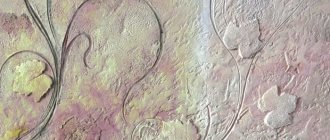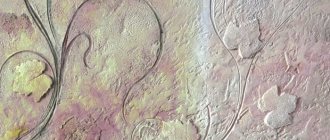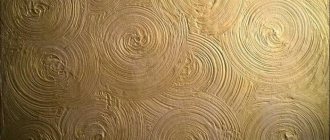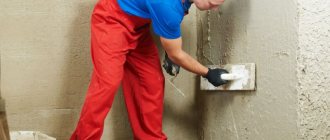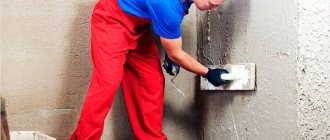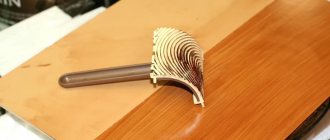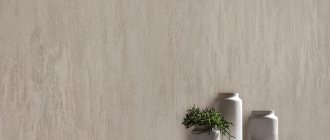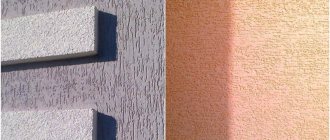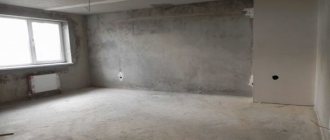Composition of decorative plaster
Manufacturers add putty, clay, and acrylic to ready-made mixtures as the main binding material. In order for the plaster to leave peculiar grooves on the surface during application, tiny fragments of stone chips, mica, and silicate glass are added to the mixture.
The following types of decorative material are popular:
- Mineral;
- Limestone;
- Polymer;
- Silicate;
- Silicone mixture.
Using different techniques for applying textured plaster, you can achieve an elegant coating with the effect of silk, velvet, or velor.
Types of binders for textured putties
Conventional putty is not always used to make a decorative textured layer. Its thickness, as we have already said, plays an important role. And if a rather impressive layer is needed to mask wall defects, then cement is used as a binding material. Such plasters can be used for facades, and not just for interior work, since they have good adhesion to the mineral base. Cement plasters are also resistant to moisture, but have a rough texture.
Epoxy and polyurethane textured putties are highly resistant to chemicals and fire. Therefore, they can also be used for external facade work. They have some limitations in use, dictated by their origin - they can be harmful and have a specific odor. In addition, polyurethane and epoxy resins can release toxins when exposed to minimal heat.
The best option is plasters based on acrylic, styrene-acrylic and polyvinyl acetate. They are diluted with water, do not threaten health and, like cement plasters, are not afraid of moisture. For the price, this is the most worthy option.
Making your own plaster
Textured plaster made from ordinary putty with additional components will be an excellent alternative to a store-bought mixture. Depending on the type of components, the composition of the finishing material changes. In any case, it should have a thick consistency to avoid sagging when applied to the walls.
From putty and PVA glue
Water is poured into the container in an amount reduced by 10 percent than indicated on the pack of dry fine-grained putty.
- Then bring it to 100% volume by adding PVA glue.
- The dry mixture is poured into the resulting water-adhesive solution, stirring it with a construction mixer.
- You can add decorative elements to the resulting composition of decorative plaster: small shells and pebbles.
Cement-lime
When diluting such plaster, it is necessary to use gloves and a respirator, since lime is a caustic substance.
The composition includes the following components:
- Lime - 1 part;
- Sand - 5 parts;
- Water - 3:1 in relation to lime;
- Cement - 1 part.
If necessary, the proportions are changed. For a stickier consistency, increase the amount of lime, and for a harder consistency, increase the amount of sand.
Limestone
You can independently prepare textured plaster using only sand and lime mortar in a 3:1 ratio. It is first necessary to prime the surfaces to be coated, especially where there are metal parts. Priming will help prevent rust from appearing on them.
Cement-sand
The composition of decorative plaster made of cement and sand is resistant to high humidity and temperature changes. Therefore, it is often used for exterior decoration.
- To dilute the solution according to the standard proportion, you will need 1 bucket of dry cement and 4 buckets of sand.
- Pour water and mix the solution thoroughly to the desired thickness.
- The listed methods for making textured plaster are the most common.
- By changing the ratios, you can weaken or strengthen the strength.
To produce optimal density, marble or quartz chips of different fractions are added to the plaster mixture.
The decoration process itself
It is quite logical that the next question to arise is how to make textured plaster with your own hands.
There are several ways to do this and each of them requires special attention: Using a roller. The roller should be either embossed, or regular, but with long pile, or with large pores.
Note!
Do-it-yourself vegetable garden: new interesting garden crafts for the street at your summer cottage (photo/video review)
DIY ceiling installation: step-by-step description of how to make a ceiling. Review of modern structures and ideas for their design (105 photos)
- Do-it-yourself garage doors - a detailed description of the construction of various types of garage doors (120 photos)
Spatula with U-shaped or V-shaped teeth. The size of the tool and the direction of its movement play a role here. And even with the most standard trowel you can draw a “fur coat”.
Household little things. And this is absolutely not a joke. For example, with crumpled film it is quite possible to get silk on the walls. A foam sponge will create a grainy texture.
Putty with filler. Quite an interesting option. People have adapted to adding sand, stone chips, foam balls, etc. to the mixture. This mixture, like store-bought, must be applied to the wall in an even layer.
Stencils and printing. Strains are sold in building materials departments. The meaning is this: the plaster is moistened with water, the piece is pressed against the wall and thus an impression appears.
As for stencils, designs are applied to a dry surface. The stencil sheet is applied to the surface, and putty is placed in the slots and smoothed with a small spatula.
Note!
Insulate the foundation with your own hands - a step-by-step description of the use of the best materials and technologies (90 photos)
- Do-it-yourself pergola on a summer cottage: step-by-step instructions with photos and descriptions
Laying laminate flooring with your own hands: a detailed description of how to lay laminate flooring. Laminate calculation, step-by-step description and installation secrets (105 photos and videos)
The paint job also looks great.
Technology of applying textured plaster
Decorative mixtures for finishing with textured plaster are distinguished by a variety of compositions.
- Using them, you can achieve an imitation of velor, silk, and relief structure.
- Each option will require a special composition and tool.
- The application technology is basically the same and includes several stages.
How to prepare a wall for applying texture plaster.
Textured plaster requires a dense base. New walls are prepared with conventional (coating) compounds - cement-sand, lime or gypsum plasters.
Previously plastered ones are cleaned, dusted (washed with water), and coated with primers.
The importance of acrylic primers should not be ignored - their purpose is to increase adhesion. An unprimed wall “bonds” worse with the decorative, textured layer.
Preparing the walls
Any plastering work is carried out on a prepared surface.
- Remove peeling paint and clean surfaces from dust.
- Large cracks are covered with putty or filled with foam using a construction gun.
- The base is washed and left to dry.
Applying plaster mixture
The mass can be applied in one layer or two, depending on the chosen technique.
- For example, decorative plaster with a velor effect is a multi-layer coating, but “furrows” can be made from a single layer.
- Each layer requires complete drying before applying the next.
- The last stage is painting the surface with a transparent varnish, as a result of which the coating becomes more attractive.
In the photo of textured plaster applied to the surface of the wall, you can see how the varnish coating shimmers.
Do-it-yourself decorative plaster of walls: main stages
For work you will need: a set of different spatulas, a grater, a plaster trowel, an angle spatula, a trowel, a level, a plumb line, a rule.
Basic tools for working with decorative plaster
Preparing the wall
The area to which the plaster will be applied is carefully protected from the remnants of the previous coating - wallpaper, paint, remnants of plaster. Exfoliated areas are removed, cracks and cracks are sealed.
Different plaster requires different degrees of surface leveling; for example, Venetian plaster will require an almost perfect surface. This is due to the fact that leveling will require a large amount of very expensive plaster. Then the surface is primed and allowed to dry.
Plaster should be applied to clean walls
Spatula and trowel
These tools can be used to imitate stones of different types, lay Venetian stones, and highlight the texture.
- Use a spatula to take a portion of plaster, apply it to a trowel and distribute it over the wall in circular and multidirectional movements.
- The trimming technique is worthy of attention, when a trowel or spatula is pressed tightly onto the applied mortar and quickly removed, forming a kind of fur coat.
This effect can be used in individual areas as small fragments.
Should I choose liquid wallpaper or textured plaster?
Many people are afraid of the difficulties of applying decorative plaster, and they prefer to simply apply liquid wallpaper to decorate surfaces. On the one hand, this is correct, because liquid wallpaper is really easier and faster to apply, but at the same time, you need to remember that textured plaster purchased or made by yourself is much more reliable than the above-mentioned composition. It can be used indoors and outdoors, it tolerates high humidity, temperature changes and so on.
Liquid wallpaper is not as strong as decorative plaster
This cannot be said about liquid wallpaper. This is a surface material, so it does not have such strength and long service life. It should also be mentioned that textured plasters are applied to walls and ceilings, while liquid wallpaper cannot be applied to horizontal planes. As for the range, liquid wallpaper wins here. They consist of synthetic materials, which allows them to be produced in different colors and textures.
Based on the above, we can conclude that liquid wallpaper is suitable if it is not possible to spend a lot of time on finishing, the walls are perfectly smooth, and the budget for repairs is large enough. In all other cases, textured mixtures will be the best solution.
Finishing walls with textured plaster is a fairly simple process that does not require any special skill. The main thing is to prepare for it: choose the right material, level the walls and create an action plan. It is also important to follow the instructions indicated by manufacturers on the packaging of decorative plaster.
Roller
Beginners are recommended to use a roller for textured plaster. You can buy a tool with ready-made ornaments or make them yourself.
To do this, a rope or coarse cloth is wrapped around the roller.
- The plaster mixture is applied to the surface with a layer of 4 mm.
- A velor roller is rolled from one edge of the ornament to the other, achieving a distinct impression.
- It is necessary to apply equal pressure so that the depth of the relief remains the same.
- Use a wet trowel to rub the hardened decorative plaster.
Final stage
After allowing the plaster to dry completely and harden (this will take at least 24 hours), it is recommended to treat the plaster with fine sandpaper - this will remove excess mortar.
Sanding a hardened textured coating
To highlight the relief of the plaster, to give it depth and clarity, coloring is used. Initially, the entire surface is painted with a long-haired roller (brush) in a darker tone. When the first layer of paint has dried, use a short-nap roller (a simple rubber roller) to apply paint of a lighter tone to the tops and protruding parts of the texture.
Painting with a lighter tone significantly enhances the “volume” effect of decorative plaster
The textured plaster in the corridor is subject to significant mechanical stress, so in order to preserve the original texture, it is protected by applying colorless varnish.
Varnishing textured plaster will greatly extend its service life.
Brushes
A simple and economical way to decorate wall surfaces.
- The mixture is applied in a thin layer, creating texture during application.
- For work, compositions with marble chips, sand, etc. are used.
- When applying the mixture with a brush, mineral fillers perfectly complement the texture and give the applied coating additional roughness.
Types of plaster for facade work
Today there are several types of plaster on the market, which differ in composition and connecting link.
| Kinds | Description |
| Mineral | The composition includes a mixture of quartz chips, marble, lime hydrant, light mineral aggregates, plasticizers and Portland cement. The advantage of this material is high strength, moisture resistance, long service life and low price. To decorate the material, pigments or marble chips are often added to the mixture, which allows you to play with the design of the walls. |
| Acrylic | In addition to sand and coarse cement, acrylic resin is added to the composition, which gives elasticity and high strength. This plaster is quite easy to work with, it can be leveled, and has good water-repellent properties. But there is also a serious drawback. Plaster is highly flammable, so it is not recommended to use it near mineral wool insulation. |
| Silicone | The main connecting link here is natural silicone, which gives extraordinary plasticity to the material. Despite the fairly high price, silicone plaster has a number of unique qualities (insensitive to UV rays, plasticity, strength, high adhesion, resistance to mechanical damage and a wide variety of colors). Another advantage is the speed of operation. The composition contains antiseptic substances, so preliminary priming of the walls before application is not required. The only drawback of this mixture, perhaps, is the complexity of finishing. That is, the walls should already be fairly well prepared before application, since silicone plaster is applied in one layer. |
Silicate | The main connecting link here is liquid glass, which imparts excellent astringent properties. Silicate plaster has a high rate of fire resistance, so it can be used on almost any surface. This is one of the most durable finishing materials, with a service life of more than 50 years. |
Cement-sand | One of the most common types, which differs from plaster only in grain size. |
Oily | It can be classified as a very exotic option for a building material that is not often found on sale. The manufacturer here uses drying oil as the basis for the thickener. It is highly resistant to moisture and is excellent for treating walls before painting. |
Epoxy | The base here is epoxy resin, which makes this building material very versatile in use. It can be applied to concrete, metal, plastic, drywall, wood. It has a very high degree of strength and resistance to external factors. |
Latex | Latex is excellent for both external wall treatment and interior use. The base is regular latex, which gives the material high elasticity. With this composition it is easy to seal all cracks and potholes on the surface. The plaster sets quickly, dries and does not form cracks. |
Prices for popular types of plaster
Plaster
Sponge, cloth
To obtain an unusual visual effect on plaster, you can use a natural sponge. The texture of images when applied is arbitrary. To create an original design, the sponge can be cut and applied with the inside of the product.
Tamponation is done with light movements. The veins from the sponge come out to have unpredictable shapes and random sizes. To achieve a polychromatic effect, it is recommended to apply several multi-colored layers. When using a natural sponge, a light, spotted pattern is obtained on the surface.
You can also use a synthetic sponge, but the pattern will be smaller. The reason is that the artificial sponge has fine porosity and a round shape.
Applying decorative plaster to surfaces is a fascinating and creative process. The most important thing is to adhere to the technological description of all stages of plastering work.
Types of textured coatings
Professional designers widely use textured wall decoration. With its help, it is easy to imitate the texture of wood, stone, various types of weaving, trellises, tapestries in wall coverings, and create various fantasy compositions on the walls. You can also achieve a similar effect yourself by decorating textured walls with your own hands. A wide selection of finishing materials allows you to creatively and inexpensively transform the surface of walls in a wide variety of styles.
Textured wallpaper
Coverings made from relief (textured) wallpaper allow you to achieve various room decoration effects. With their help, you can visually adjust the proportions of the interior - “push apart” the walls and “raise” low ceilings. Thanks to the use of modern technologies, the texture of such wallpaper successfully imitates various materials, evens out uneven walls and works wonders with the volume of the room.
The following textured wallpaper options are available for sale:
- paper - initially, such wallpaper imitated the texture of tapestries and trellises thanks to special printing methods. Currently, textured wallpaper for walls has acquired a real relief. In them, a two-layer (duplex) wall covering consists of a decorative paper layer attached to a paper or non-woven base. At the same time, decorative relief on them is created by embossing, artistic printing, or using other technologies. Modern textured wallpaper, made from high-quality material, is distinguished by its fade-resistant coloring and wear resistance, and can last for 5-10 years - until the next cosmetic repair. Textured wall decoration with paper wallpaper is suitable, among other things, for a children's room or bedroom, since these finishing materials are environmentally friendly and have excellent breathability;
- vinyl - such wallpaper consists of a layer of polyvinyl chloride (PVC) placed on a base made of technical paper or non-woven fabric. To do this, a foamed polymer mass using special technologies is applied to the base layer, forming a textured decor. The technology for producing silk-screen wallpaper using complex embossing makes it possible to imitate ancient wallpaper textiles (the so-called damask). Vinyl wallpaper is suitable for decorating the walls of various rooms, including those with high humidity conditions - kitchens, bathrooms, as they do not absorb moisture, can be easily washed using various household chemicals, and are resistant to significant temperature changes. Vinyl wallpaper with micropores, which recently appeared on the market, has increased breathability and allows the walls to “breathe”, while water that gets on their surface quickly evaporates without being absorbed into the coating. Thus, moisture does not accumulate on the walls under the wallpaper, therefore, fungus or mold will not appear under them;
- non-woven wallpaper - such wallpaper is made from polyester and acrylic with the addition of natural viscose fiber using the hot pressing method without the use of chemicals. Such wallpaper is environmentally friendly, elastic and little susceptible to deformation. In addition, they have excellent soundproofing properties and provide ample opportunities for decoration. Currently, non-woven wallpaper with a relief texture in an ethnic style, as well as corrugated wallpaper, are very popular;
- natural wall coverings made from natural materials (which can be sisal, cork, bamboo, jute, reed, tree bark). Such textured wallpapers are quite expensive. They are suitable for various rooms, including those with high humidity, although it is still not recommended to place them in close proximity to a bathtub, washbasin and shower;
- wallpaper for painting - vinyl, as well as paper with a layer of wood shavings. This wall covering of white, cream, greenish color differs from painted wallpaper in its pronounced relief, which will take on its final appearance after applying paint of the selected shade;
- Glass wallpaper is a woven or wicker covering on a paper base. Such structural wallpapers are painted with acrylic or silicone paints. Fiberglass wallpapers are highly resistant to abrasion and detergents, so they can be used to decorate frequently visited rooms - corridors, halls, hallways.
Textured paint
Textured paints are widely used for interior decoration in various styles, as well as for exterior work. This finishing material in its structure resembles decorative plaster and is a viscous white mass with various inclusions. Acrylic, silicate or silicone dispersions can be used as the basis for textured paint. In addition, mineral fillers of various grain sizes are added to its composition - granite or marble chips, gas silicate, quartz sand, as well as artificial materials - polymer fibers, which form a certain texture and different relief on the surface of the coating. Initially, textured wall paint is produced in white color, but it is easy to give it any shades you like by adding a special dye (color paint) of a suitable shade. On sale are textured paints for the basement of a building, façade, and also for interior work.
Textured painting of the walls will help to even out small unevenness and create a uniform coating on them. Thus, before applying paint, the walls do not need to be leveled to a state of perfect smoothness; it is enough to clean their surface from debris and peeling plaster, and then prime it for the subsequent application of structural paint. The primer will promote better adhesion of the textured coating to the walls.
The following advantages of textured paint can be noted:
- high breathability - even a thick layer of coating allows the walls to “breathe” without creating a barrier to moisture and steam;
- structural paints do not contain solvents, such finishing is safe for health;
- high frost resistance, allowing this finishing material to be used for outdoor work;
- Thanks to the acrylic binder component, structural paints are resistant to various weather conditions. This textured wall covering is characterized by high wear resistance and durability.
It is worth noting that for textured wall finishing you will need a significant consumption of structural paint - about 500-1500 g/m2. This is explained by the thickness of the textured coating, which can reach 1 cm (while facade paints are usually applied in a layer of 0.2-0 .3 mm). Textured paint is applied to the walls with a special roller; in addition, it is convenient to use a powerful vacuum cleaner or a specialized pumping station, which can be purchased or rented, to apply the textured coating.
Textured plaster
Currently, wall decoration with textured plaster is becoming increasingly popular, making it possible to create various decorative coatings on the walls. Thanks to the presence of special binders and forming additives in its composition, it is possible to create wall coverings with various patterns and reliefs.
Depending on the composition, the following types of this finishing material are distinguished:
- acrylic plaster is made on the basis of acrylic resin. This material is sold in the form of a ready-made mixture, which is conveniently applied to various building surfaces. This coating is elastic and, if necessary, will hide small cracks on the wall caused by shrinkage. The disadvantages of acrylic plaster include the lack of breathability, as well as the ability to absorb and accumulate dust, which can cause the façade coating to fade over time;
- In silicone plaster, silicone resins act as a binding component. This finishing material is characterized by high plasticity, ease of application and durability (service life - up to 25 years), suitable for mineral and other surfaces, breathable and does not absorb salt, used for external and internal work;
- mineral plaster is sold in the form of a dry mixture based on cement and sand, which must be mixed immediately before use. Mineral chips in the plaster give this coating the desired relief. This plaster is easy to use; even a novice master can handle its application. The disadvantages of this type of plaster include a short service life (up to 10 years), as well as a lack of elasticity and the possibility of cracks appearing on the facade;
- silicate plaster can be purchased in the form of a ready-made mixture. This finishing material is quite plastic and easy to apply. The silicate textured coating is elastic and crack-resistant, durable and breathable, has antistatic properties and does not attract dust.
Particularly popular for finishing are textured plaster for walls of the “bark beetle” and “marble” varieties - the first got its name because of the characteristic coating, reminiscent of wood eaten away by a bark beetle, the second - due to the presence of marble chips and dust in its composition.
For interior work, it is recommended to choose a textured putty for walls of a fine-grained composition or plaster with granules of various grain sizes (without the presence of particularly large ones) - such a relief finish will look quite organic on the walls of the room. You can obtain a uniform, rough coating of external walls using compositions with calibrated marble and granite filler. If there are large inclusions in the plaster, you will need to use a steel trowel instead of a roller.
The advantages of using textured plaster for walls include ease of application and plasticity - with its help it is easy to decorate textured walls with your own hands without having experience in such work, as well as ample opportunities for decorating walls. Using this finishing material, you can create various types of coatings simulating marble or sand surfaces, rocky terrain, and fantasy patterns. At the same time, the color range of wall decoration is not limited - you can purchase a ready-made colored solution or select the colors yourself, adding color paint in the desired shades. In addition, the textured plaster coating is resistant to mechanical and atmospheric influences, strength and durability.

